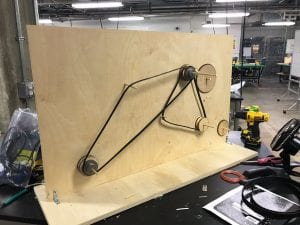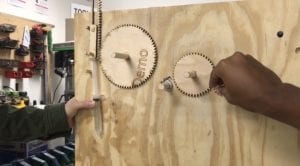In week 5, it was all about prototyping and building a functional product. We began with a medium fidelity prototype, mainly to see how the mechanical aspect of our design would function. We especially were interested to know if our hours of calculations for synchronizing the syringe pump and the film reel were correct.
In this prototype, we implemented the gear system but did not actually attempt to coat any emulsion. We laser cut the gears, rack, and pulleys out of wood, which was a new skill I recently got to learn. After we had all of the gears, we carefully placed them onto a wooden board, connecting the pulleys with a belt. Amazingly, our calculations were correct! The rack-and-pinion mechanism pumped all 10 mL of solution over the course of the film is rotated around one time so that all of the film in the reel would come in contact with the syringe pump and roller. We did not try to use this prototype to actually apply the emulsion because it was built on a smaller scale, but overall, we were assured that the mechanism would suit our needs.
There were, however, a few problems that needed solving. One, the belt we used slipped a lot, which made it difficult for the entire mechanism to synchronize well. This was mainly due to the fact that we made the pulleys ourselves, so they were smooth and not perfectly made. In addition, we found that we did not need to use so many gears to achieve the design we wanted. We were able to remove one gear for our future prototype, which increases the efficiency of the overall design.
After we felt comfortable with this prototype, we decided to move onto another medium fidelity, to-scale prototype. Our intentions with this prototype were to implement the gear mechanisms that we now know function correctly as well as connect the film reel to actually start coating the film with the emulsion. We rapidly assembled the gear system, but we encountered a new problem. The belt we previously used was not long enough nor were there any other suitable belts. We tried to improvise with using rubber tubing that had more friction, but unfortunately, it was difficult to connect these together. In the end, we decided to purchase industrial timing-belts and timing-pulleys, which are specifically designed to achieve our desired synchronization. These worked amazingly, and the belt issue was solved for now.
Because this was a medium fidelity prototype, constructed primarily out of wood, the wooden shafts began to splinter and break down over the course of using it so many times. The added weight of the metal pulleys compounded this issue. As a result, we had to remove our hand crank and are planning on replacing it. We also want to further tweak our prototype to make it stable enough to use consistently. This includes adding a backboard to limit the gears to turn along one axis and not several as well as further securing the belts and pulleys together.
We also decided to test how well our syringe and its insulator can retain the desired temperature. Over the course of ten minutes, we readily measured the temperature of the gelatin emulsion. Unfortunately, the gelatin emulsion did dip below the desired 40°C threshold, but just barely at 38°C. We are confident we can solve this issue with some ease.

Back of to-scale prototype
This is where we have ended today, with an almost-functioning prototype that is close to being able to test. Our main issue is the durability of the wood at this point, so I am half-thinking that we could worry about the testing later and build a high-fidelity prototype that is well-made and much smoother so that we could get more accurate results. In this high-fidelity prototype, we would be using a lot more metal gears, shafts, and pulleys to achieve a more precise and consistent performance out of our machine, which is the ultimate goal. We will probably begin building the high-fidelity prototype next week if we think our current prototype is insufficient.



Your writing is consistently clear and well-organized. You give a strong introduction giving the purpose of your work the past week, what you have learned (such as to laser cut), and a clear account of your progress, problems, and possible ways to solve them. Your organized thinking from the standpoint of a problem solver is also obvious in the effective way you express it.